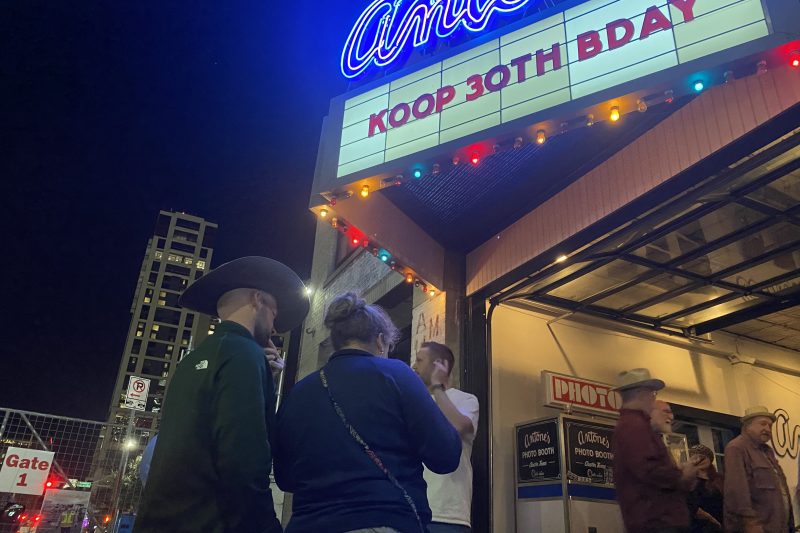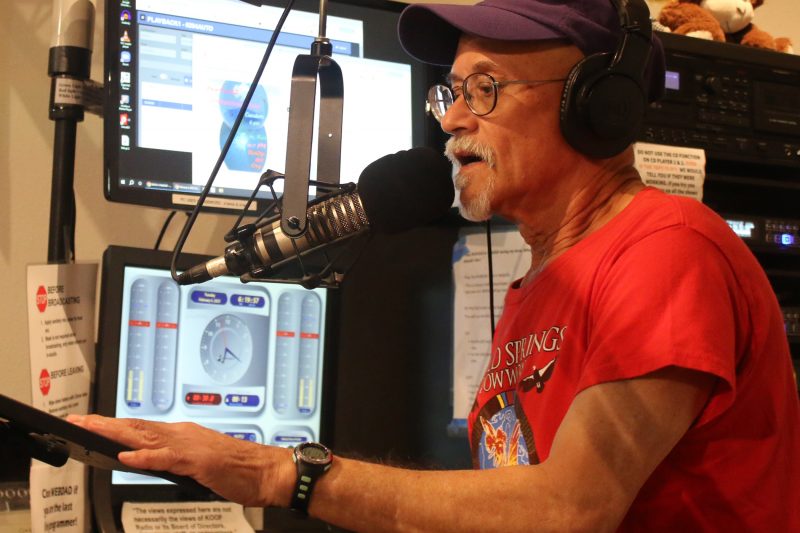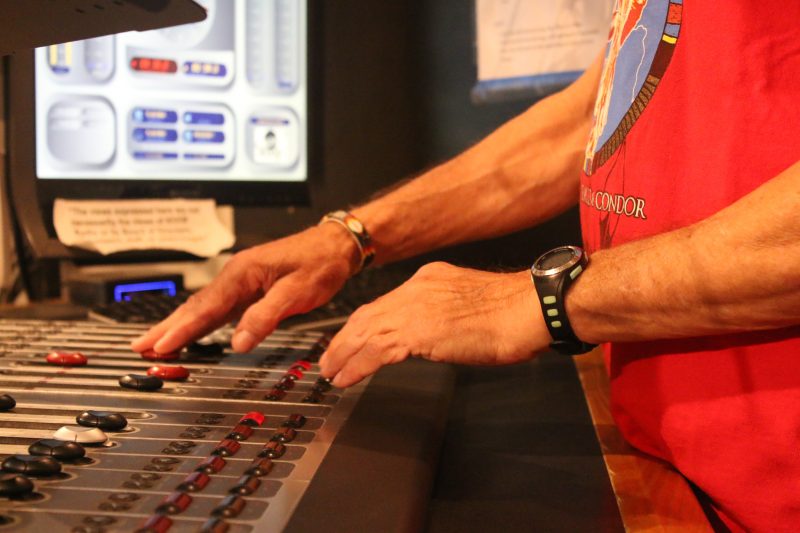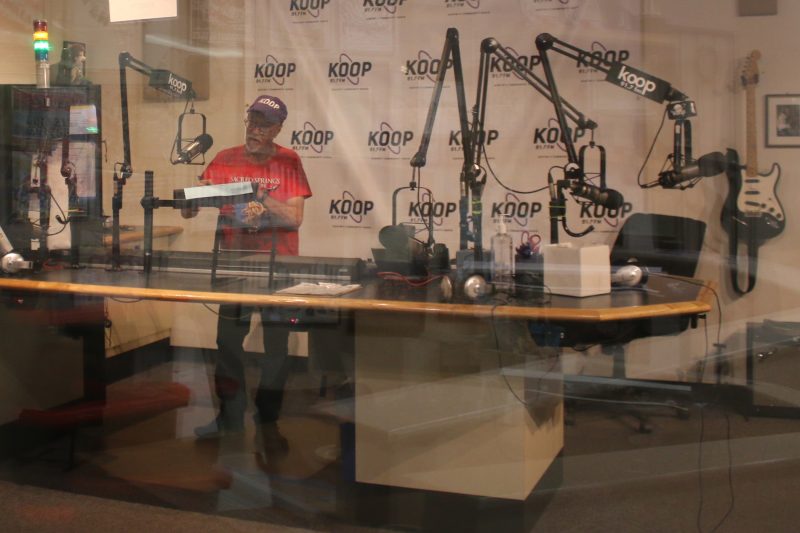Uniquely Austin Radio Station KOOP Celebrates 30 Years on Air
By Amber Williams
Reporting Texas

Attendees stand outside of Antone’s Nightclub during KOOP radio stations’s 30th anniversary celebration in Austin, Texas, on Feb. 1, 2025. The event drew a full house. Amber Williams/Reporting Texas
“Happy Birthday KOOP,” Shinyribs’ frontman Kevin Russell announced from a purple-lit stage at Antone’s Nightclub. The tightly packed crowd swayed like sea grass as waves of reggae-sprinkled soul-funk flowed from the eight-piece band. “Never trust anyone over 30, though,” he joked.
On this February night, attendees celebrated three decades of Austin’s only cooperatively run radio station. Since inception in the early 90s, the nonprofit has stacked up 30 Best of Austin awards from the Austin Chronicle, helped coin the city’s iconic “Keep Austin Weird” slogan and emerged as an amplifier of diverse community voices, all while weathering a rocky history and changing media landscape.
Hailing from 91.7 FM, the station features over 60 weekly programs dispersed across a seven-day schedule spanning news commentary, public service awareness, variety show-style comedy and a flavorful selection of music. While traditional radio stations staff private teams, KOOP is powered by volunteers.
“The lifeblood of volunteers is the lifeblood of the station,” board president Jean Anne Lauer said.
Anyone willing to meet the station’s weekly volunteer time commitment earns membership, a vote at general meetings and the chance to produce a show. The byproduct of this collective approach?

Board member Ken McKenzie-Grant broadcasts Indigenous music on the “HeartbeatZ Indigenous Hour,” one of the many niche programs broadcast on KOOP. Amber Williams/Reporting Texas
“You have all these different genres and niches that [don’t] get filled by your average radio station,” said Rick McNulty, KUTX music director and former KOOP programmer.
Saturday mornings kick off with “Graveside Service,” a program commemorating celebrity “deathversaries.” “The Lounge Show” follows the hour spanning beatnik jazz, spy themes and thrift store discoveries, among other nuanced categories. By the end of the day, listeners can tune in for an exploration of underground rock sourced across different decades and countries.
“I had a Spotify account for a year, and I didn’t find it useful for me, because what I’m interested in is not the stuff that most people are interested in,” said Ken McKenzie-Grant, KOOP board member and host of “HeartbeatZ Indigenous Hour.” Every Tuesday night, McKenzie-Grant broadcasts a curated line up of songs by musicians with indigenous roots.
Making space for alternative tastes is one way KOOP underscores community. In tandem, the station spotlights Austin-area nonprofits, organizations and individuals making a local impact through weekly programming. Volunteers are also encouraged to clock their hours outside of the studio by planting trees with environmental nonprofits, spinning tunes at downtown holiday bazaars or plucking litter off the shoulders of Manor Road.
“We’re literally out in our community, keeping our community a clean, safe environment for people to get to know each other,” Lauer said.

Frontman Kevin Russell, left, and back vocalist Mars Wright perform with local cross-genre band Shinyribs at Antone’s Nightclub during KOOP’s 30th anniversary celebration in February. Amber Williams/Reporting Texas
The birthday bash not only celebrated KOOP’s present-day achievements, it also nodded to the station’s bumpy past. It was Dec. 17, 1983, when KOOP co-founder James R. (Jim) Ellinger celebrated his own 30 laps around the sun at a housing cooperative nestled west of the University of Texas. Party chatter turned into a proud claim by Ellinger, then an Austin Chronicle radio columnist with a history in community programming. He claimed he could launch a station more reflective of local music and politics than current media offerings.
“I said, ‘Hell, I could create a better radio station than this,’” Ellinger said.
The party guests held him to it, and soon Ellinger and a small team found themselves lobbying the Texas senate to change a 1972 treaty — a move that would free 91.7 FM, the last non-commercial frequency in Central Texas. After that, it was sketching up design plans for a broadcasting tower and filing for a license with the FCC.

Board member Ken McKenzie-Grant adjusts audio levels while airing “HeartbeatZ Indigenous Hour” live at the station. He curates a new playlist of songs by Indigenous artists weekly. Amber Williams/Reporting Texas
Just as the finish line grew into focus, a competitor emerged. The student cable radio station at UT, now KVRX, applied for the same frequency two days before the license application closed. Bitter exchanges between the rival groups finally settled with a court order to share the frequency. The compromise still holds today as KOOP airs until 7 p.m. on weekdays and 10 p.m. on the weekends while KVRX covers the night hours.
The station finally launched in a small studio on E. Fifth Street, more than 10 years after the initial pitch. But the drama had only begun. Within a few years, internal power struggles grew into a lawsuit between board members and station volunteers that many away, including Ellinger. Then, in the mid aughts, the station caught ablaze — three times — first by a careless smoker, then by a faulty air conditioning unit and finally by one of KOOP’s own members after a programming dispute, according to news reports.
“My immediate thought was, ‘Is this it?’” Charlie Martin, longtime programmer and staffer said.
It wasn’t. Although forced to relocate two times, the station survived thanks to community donations, public grants and volunteers.
KOOP now faces a slow-burning, wider challenge: the ever-shrinking attention span for radio consumption.
“You’re not competing against other radio stations as much as you’re competing against every distraction, every stream in life,” McNulty said.
But McNulty said local radio still offers something unique.

Board member Ken McKenzie-Grant broadcasts live from behind KOOP’s studio glass. The station’s 60 weekly programs are powered entirely by volunteers. Amber Williams/Reporting Texas
“It’s the real deal,” he said. “It’s live radio. It’s people talking to you that are going through the same things that you’re going through in your city,”
This call to a higher purpose not only keeps KOOP on air but drives Lauer and her team to push the roof. The station recently launched a Capital Campaign to raise $60,000 for studio equipment upgrades. Lauer said her team is also exploring ways to reach global audiences and invite 18 to 25-year-olds into radio production through expanded internship opportunities.
Big goals might bring hurdles. But KOOP has cleared a few.